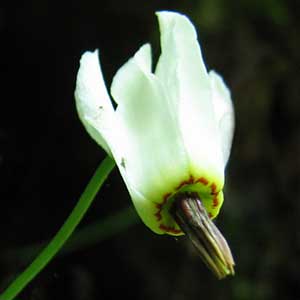Dodecatheon dentatum
Dodecatheon redolens
dentate shooting star, tooth American cowslip, white shooting star
scented shootingstar
not obvious at anthesis, or sometimes erect to slightly horizontal, slender;
roots white or reddish;
bulblets absent.
not obvious at anthesis or horizontal, short, thick;
roots tan to dark reddish brown;
bulblets absent.
(3.5–)8–20(–30) × (1–)2.5–6(–7) cm;
petiole slightly winged;
blade ovate, base decurrent onto stem, abruptly tapering to petiole, margins subentire to sinuate or crenate, surfaces glabrous.
20–50(–60) × 2.5–6 cm;
petiole usually winged;
blade oblanceolate, base decurrent onto stem, gradually tapering to petiole, margins entire, surfaces minutely glandular-pubescent.
(1–)2–5(–11)-flowered;
bracts lanceolate, 1.5–5(–8) mm, glabrous.
5–15-flowered;
bracts lanceolate to broadly lanceolate, 5–17 mm, glandular-pubescent.
0.8–5 cm, glabrous.
2–9 cm, glandular-pubescent.
calyx light green, 4–6 mm, glabrous, tube 2–3.5 mm, lobes 5, 1.5–3(–4) mm;
corolla tube yellow with red, thin, wavy ring, lobes 5, white, 7–18(–20) mm;
filaments distinct, maroon to black, 0.1–0.5 mm;
anthers (4.5–)5–7.5 mm;
pollen sacs maroon to black, connective dark purple to maroon, smooth;
stigma not enlarged compared to style.
calyx light green, 10–18 mm, glandular-pubescent, tube 3–10 mm, lobes 5, 5–12 mm;
corolla tube yellow with maroon, thick, often wavy ring, ring rarely absent, lobes 5, magenta to lavender, 14–30(–35) mm;
filaments distinct, dark maroon to black, 0.2–0.8 mm (usually concealed by corolla tube);
anthers 7–11 mm, (apex acute);
pollen sacs maroon, connective dark maroon to dark purple, transversely rugose;
stigma enlarged, diam. usually 2+ times style.
pale greenish to tannish, dark yellow apically, valvate, narrowly ovoid, (6–)8–11 × 3–5 mm, glabrous;
walls thin, pliable.
light brown, often reddish brown apically, valvate, ovoid, 8–17 × 5–9 mm, glandular-puberulent or glabrous except for glandular-puberulent teeth;
walls thin, pliable.
without membrane along edges.
with thin membrane along edges.
= 44.
Dodecatheon dentatum
Dodecatheon redolens
Dodecatheon dentatum occurs mainly on the eastern slope of the Cascade Range from south-central British Columbia to central Washington, with disjunct populations near the Columbia River in southwestern Washington, the Columbia River Gorge, northeastern Oregon, and northern Idaho. In Idaho, this species occasionally forms hybrids with D. pulchellum var. pulchellum (Oberle 262, MO).
(Discussion copyrighted by Flora of North America; reprinted with permission.)
Dodecatheon redolens occurs mainly in the high mountains of the southern Sierra Nevada, with scattered populations in the San Bernardino, San Gabriel, and San Jacinto mountains of southern California. Elsewhere in California, it occurs on scattered desert ranges in the northern Mojave Desert. In the Intermountain West, it is found occasionally in Inyo and Mono counties on the eastern foothills of the Sierra Nevada, the White Mountains, and on or near Glass Mountain. It is found across central Nevada to the Independence and Ruby mountains of Elko County, and the Deep Creek Range of west-central Utah.
Although difficult to see, a fairly good feature of Dodecatheon redolens is that the corolla tube usually covers the filaments and proximal end of the anthers. In both D. jeffreyi and D. alpinum, the corolla tube does not cover the base of the anthers. In addition, the tips of the anthers in the latter two species are truncate to obtuse; in D. redolens they are acute.
(Discussion copyrighted by Flora of North America; reprinted with permission.)


